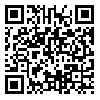Volume 9, Issue 2 (3-2013)
JSDP 2013, 9(2): 37-48 |
Back to browse issues page
Abstract: (13547 Views)
In this study, Recurrence Plots (RPs) has been adapted as a nonlinear approach in order to detection of guilty subjects’ knowledge based on their single-trial ERPs. The dataset were acquired from 49 human subjects who were participated in a Concealed Information Test (CIT). According to the test protocol, guilty subjects denied their information about familiar faces, so the aim was to detect the concealed faces in these subjects. Recurrence quantifiers were employed in feature extraction stage. Chaotic dynamic of brain’s signals and figuring out the trajectories in phase space are two important issues that can be indicated in these quantifiers. Results demonstrate, that the appearance of P300 signals in guilty subjects (because of denying a familiar face), increase the determinism and predictability of their brain’s signals. Also using Genetic Algorithm (GA) in feature selection level together with Linear Discriminant Analysis (LDA) classifier and a new method named: “inconstant threshold detection”, we achieved an accuracy about 89.7% on combining information of Fz, Cz and Pz channels.
Type of Study: Research |
Subject:
Paper
Received: 2013/06/5 | Accepted: 2013/09/17 | Published: 2013/09/17 | ePublished: 2013/09/17
Received: 2013/06/5 | Accepted: 2013/09/17 | Published: 2013/09/17 | ePublished: 2013/09/17
| Rights and permissions | |
 |
This work is licensed under a Creative Commons Attribution-NonCommercial 4.0 International License. |


